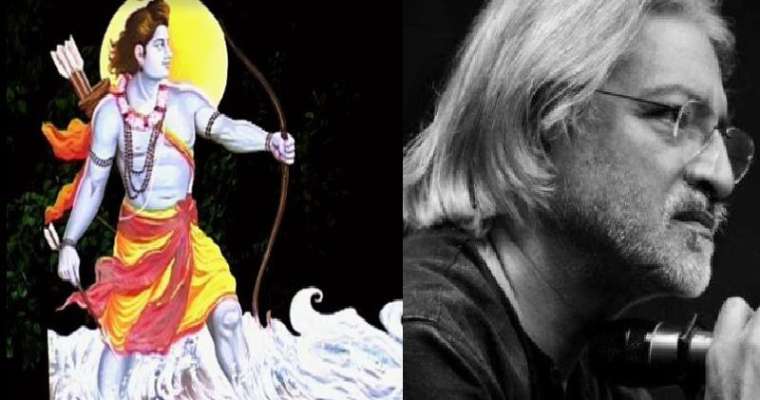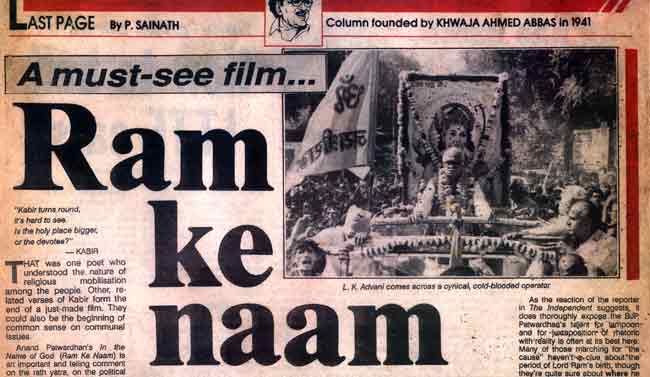YouTube has imposed an age restriction on Anand Patwardhan’s documentary Ram Ke Naam. According to YouTube’s community guidelines, content that is age restricted is not visible to users under the age of eighteen and if a user is not logged in. The highly acclaimed documentary, made in 1991-92, is relevant in the current political climate as it lays bare the political agenda of the RSS and the BJP and leaves a lasting impression on the viewers mind. Patwardhan reacted to the age restriction in a Facebook status on 11 February 2018. He wrote, “Disgusting!!! Now if you are a child over 14 and under 18 you are allowed to do hazardous labour but you are not allowed to see Ram Ke Naam! The temporary good news is that if you are over 18 you can watch Ram Ke Naam on my anandverite YouTube channel. That is, till they think up a new ruse to restrict it further.” Anand Patwardhan is known for his hard-hitting political documentaries like Jai Bhim Comrade, Father, Son and the Holy War, and Reason.

Patwardhan appealed to YouTube against the decision. They reviewed the appeal and informed him through an email that though the film did not violate their community guidelines, it still may not be “appropriate” for a general audience.
Ram Ke Naam, first aired in 1992 — a few months before the Babri Masjid demolition, follows the campaign started by the Vishwa Hindu Parishad to build a Ram Temple where the Babri Masjid stood. The VHP claimed that the Masjid was built on the birth place of Ram. The film also documents the rath yatra launched by LK Advani to rally support for the Ram Temple. The documentary won the National Film Award for Best Investigative Documentary and the Filmfare Award for Best Documentary. The movement culminated in the demolition of the Babri Masjid on 6 December, 1992.

To decide whether content should be age restricted, YouTube claims to use the following considerations – “Vulgar language, Violence and disturbing imagery, Nudity and sexually suggestive content, and Portrayal of harmful or dangerous activities”. However, from their communication to Patwardhan, it would seem that over and above the stated criteria “suitability” is also a factor. Talking to the Indian Cultural Forum about the arbitrariness of such decision-making, Patwardhan says, “Some may argue that since YouTube owns the space, who are we to complain? But I think all this hits against net neutrality. Just as we fight for democracy in real life, we must fight for it on the internet. If money controls opinion and visibility, it is a dark and dangerous path to tread.”
It is quite evident that the money the advertisers bring in, along with their unspoken prejudices, is very often the key to age-restriction decisions. In January this year, YouTube released an original series Wayne, which was full of violence and profane language and violated most, if not all, of the stated community standards. YouTubers such as PewDiePie and RackaRacka, who have suffered on account of YouTube’s policies, were quick to point out the double standards, and after such protests, YouTube imposed viewership restrictions on Wayne.
It is worth noting that Patwardhan’s documentary received a U certificate from the Central Board of Film Certification (CBFC) when it was released in 1992. It was even broadcast by Doordarshan-1 during prime time after a High Court directive. It is ironic that YouTube, which claims to have a relaxed attitude towards censoring content, and not the Indian Censor Board with its famously fragile sensibilities, was the one that chose to restrict viewership of the film. Patwardhan highlights the fatuousness of the claim that Ram ke Naam is “inappropriate” when he says, “These are films that build communal harmony by showing the ugly side of hate mongers and the positive secular mindset of ordinary Indians. If they promoted violence they could not have a “U” certificate.”
This is not the first time Anand Patwardhan’s films have been targeted by YouTube. His channel “anandverite” had been demonetised earlier. YouTube monetises a video or a channel depending on the number of views the video receives. If it crosses the 10,000 views mark, YouTube monetises the video by showing advertisements before and during its streaming. Advertisers have the final say on what content they want their advertisements shown on. In March 2016, YouTube came under fire after a report in the London Times on how advertisements were shown during videos containing extremist views. Advertisers such as the American multinational AT&T, among others, withdrew their ads from YouTube after they had been shown alongside objectionable content. YouTube since has changed its policies about what content gets monetised.
Many YouTubers, such as brothers Daniel and Michael Phillippou who run the channel RackaRacka, claim that if a video is both age restricted and demonetised, it becomes virtually impossible to find it even using the YouTube search engine. It also stops being featured on the trending list and the recommended tab.
The political implications of such intervention are obviously not lost on Patwardhan, The film maker says, “Both demonetising and age restricting serve to pull down the rating of the channel so as to restrict viewership. This is nothing less than an arbitrary act of censorship undertaken just before elections…The likely truth is that Hindutva elements within YouTube/Google are looking to curb secular, democratic content.”
YouTube, of course, did not provide any concrete reason for demonetising Patwardhan’s videos apart from calling the content “not appropriate.”
Other progressive Indian film makers too have suffered censorship at the hands of Youtube. Most such instances, however, went unreported. Patwardhan points out, “My friend Satyen Bordolai who films protest rallies and progressive talks and panels on his YouTube site, found that his channel was also demonetised and age restricted. It is as if they are saying that in order to not invite trouble on YouTube, your content has to be right of centre.”
It is undeniable that YouTube, like Facebook and WhatsApp, can and has served as a vital tool in the propaganda machinery of the RSS-BJP. Restricting access to hard-hitting and critical political content such as Anand Patwardhan’s documentary serves one vital purpose: to reduce viewership by hook or by crook, a strategy pursued by the Right-wing since time immemorial.
The Right-wing government at the Centre, along with the machinery of the Sangh, will stop at nothing to further their agenda. It is widely known that they have been trying to control public and private institutions across the country. It would not be a far-fetched fantasy to believe that they would try to infiltrate, influence and utilise to their benefit portals like YouTube.
Attempts were made to contact YouTube/Google for a comment. Till the time of filing of this story, no response had been received. As soon as a response is received, the story will be updated.
Courtesy: Indian Cultural Forum